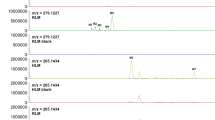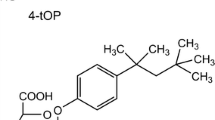Abstract
Adult female Wistar rats (n=48) divided into four groups of 12 were treated orally with 3 mg/kg per day thalidomide, a 0.05% hexachlorobenzene (HCB) — containing diet, with both drugs together and with the vehicles (controls) over periods of 10 and 60 days. The protein and P450 contents and the activities of amino-pyrine-N-demethylase (ADM) and 7-ethoxyresorufine-O-deethylase (7-ERO-D) were determined in the liver microsomes. The activity of 7-ERO-D was also determined in the skin microsomes and total porphyrins were measured in the urine of the animals. Thalidomide increased the hepatic P450 content, caused distinct changes in the activities of the hepatic and cutaneous microsomal isozymes, modified their induction by HCB and inhibited the porphyriogenic activity of HCB. These findings indicate an interaction between thalidomide and HCB with regard to their effects on the P450 isozymes and the metabolism of porphyrins.
Similar content being viewed by others
References
Braun AG, Harding FA, Weinreb SL (1986) Teratogen metabolism: thalidomide activation is mediated by cytochrome P-450. Toxicol Appl Pharmacol 82: 175–179
Burrows NP, Walport MJ, Hammond AH, Davey N, Russell Jones R (1991) Lupus erythematosus profundus with partial C4 deficiency responding to thalidomide. Br J Dermatol 125: 62–67
Doss M, Schmidt A (1971) Rapid determination of urinary total porphyrins by ion exchange chromatography. Z Klin Biochem 9: 415–418
Doss M, Schermuly E, Koss G (1976) Hexachlorobenzene porphyria in rats as a model for human chronic porphyrias. Ann Clin Res 8 [Suppl 17]: 171–181
Goerz G, Lissner R (1987) Die Hexachlorobenzol (HCB)-Porphyrie. Zentralbl Haut 153: 505–524
Goerz G, Krieg T, Bolsen K, Lissner R (1977) Langzeitexposition von Ratten mit Hexachlorobenzol (HCB): EinfluΒ auf die Porphyrin-Ausscheidung im Urin und auf das Cytochrom P-450 in der Leber. Arch Dermatol Res 259: 199–206
Goerz G, Vizethum W, Tsambaos D (1979) Cutaneous cytochrome P450 activity during hexachlorobenzene-induced experimental porphyria in rats. Arch Dermatol Res 265: 111–114
Goerz G, Berger H, Tsambaos D (1981) A new animal model for the study of cutaneous drug-metabolizing enzymes. Arch Dermatol Res 270: 3667–369
Goerz G, Bolsen K, Merk H (1985) Influence of chloroquine on the porphyrin metabolism. Arch Dermatol Res 277: 114–117
Gordon GB, Spielberg SP, Blake DA, Balasubramanian V (1981) Thalidomide teratogenesis: evidence for a toxic arene oxide metabolite. Proc Natl Acad Sci 78 (4): 2545–2548
Gorin I, Vilette B, Gehanno P, Escande JP (1990) Thalidomide in hyperalgic pharyngeal ulceration of AIDS. Lahcet 335: 1343
Koch HP, Czejka MJ (1986) Evidence for intercalation of thalidomide into DNA: clue to the molecular mechanism of thalidomide teratogenicity. Z Naturforsch [c] 41: 1057–1061
Lowry OH, Rosebrough NJ, Farr AL, Ranall RJ (1951) Protein measurement with the folin phenol reagent. J Biol Chem 193: 265–275
Lui H, Sweeney GD (1975) Hepatic metabolism of hexachlorobenzene in rats. FEBS Lett 51: 225–226
Meilin GW, Katzenstein (1962) The saga of thalidomide: neuropathy to embryopathy, with case reports of congenital anomalies. N Engl J Med 267: 1184–1244
Morris CR, Cabral JRP (1986) Hexachlorobenzene. In: Morris CR, Cabral JRP (eds) Proceedings of an International Symposium. (IARC Scientific Publication no 77), pp 1–247
Naafs B, Bakkers EJM, Flinterman J, Faber WR (1982) Thalidomide treatment of subacute cutaneous lupus erythematosus. Br J Dermatol 107: 83–86
Omura T, Sato R (1964) The carbon monoxide-binding pigment of liver microsomes. J Biol Chem 239: 2370–2386
Pohl RJ, Fouts JR (1980) A rapid method for assaying the metabolism of 7-ethoxyresorufin by microsomal subcellular fractions. Anal Biochem 107: 150–155
Revuz J, Guillaume J-C, Janier M, Hans P, Marchand C, Souteyrand P, Bonnetblanc J-M, Claudy A, Dallac S, Klene C, Crickx B, Sancho-Garnier H, Chaumeil JC (1990) Crossover study of thalidomide vs placebo in servere recurrent aphthous stomatitis. Arch Dermatol 126: 923–927
Schoene, Fleischmann RA, Remmer H, von Olderschaudsen HF (1972) Determination of drug-metabolizing enzymes in needle biopsies of human liver. Eur J Clin Pharmacol 4: 65–73
Sheskin J (1980) The treatment of lepra reaction in lepromatous leprosy. Int Dermatol 19: 318–322
Sheskin J, Convit J. (1969) Results of double blind study of the influence of thalidomide on the lepra reaction. Int J Lepr Other Mycobact Dis 37: 135–146
Stonard MD (1975) Mixed type hepatic microsomal enzyme induction by hexachlorobenzene. Biochem Pharmacol 24: 1959–1963
Winkelmann RK, Connolly SM, Doyle JA, Padilha-Goncalves A (1984) Thalidomide treatment of prurigo nodularis. Acta Derm Venereol (Stockh) 64: 412–417
Author information
Authors and Affiliations
Rights and permissions
About this article
Cite this article
Tsambaos, D., Bolsen, K., Georgiou, S. et al. Effects of oral thalidomide on rat liver and skin microsomal P450 isozyme activities and on urinary porphyrin excretion: interaction with oral hexachlorobenzene. Arch Dermatol Res 286, 347–349 (1994). https://doi.org/10.1007/BF00402227
Received:
Issue Date:
DOI: https://doi.org/10.1007/BF00402227




